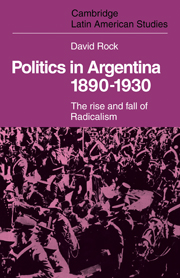Book contents
- Frontmatter
- Contents
- Preface
- 1 The components of Argentine society, 1890–1914
- 2 The oligarchy and institutional reform, 1880–1916
- 3 The rise of Radicalism, 1891–1916
- 4 The workers and their politics in Buenos Aires, 1890–1916
- 5 The first Radical government, 1916–22
- 6 The strikes, 1916–18
- 7 The Semana Trágica
- 8 1919
- 9 Postscript to the first presidency, 1920–2
- 10 The Alvear interlude, 1922–8
- 11 Yrigoyen's second presidency, 1928–30
- 12 Perspectives
- APPENDIXES
- 1 The occupational and class structure of the male population of the city of Buenos Aires by nationality, 1914
- 2 The rise of Radicalism – an historiographical note
- 3 The first Radical government and the Argentine Rural Society
- 4 The working class vote for the Radical and yrigoyenista parties in selected areas of Buenos Aires, 1912–30
- Select bibliography
- Index
3 - The first Radical government and the Argentine Rural Society
Published online by Cambridge University Press: 04 August 2010
- Frontmatter
- Contents
- Preface
- 1 The components of Argentine society, 1890–1914
- 2 The oligarchy and institutional reform, 1880–1916
- 3 The rise of Radicalism, 1891–1916
- 4 The workers and their politics in Buenos Aires, 1890–1916
- 5 The first Radical government, 1916–22
- 6 The strikes, 1916–18
- 7 The Semana Trágica
- 8 1919
- 9 Postscript to the first presidency, 1920–2
- 10 The Alvear interlude, 1922–8
- 11 Yrigoyen's second presidency, 1928–30
- 12 Perspectives
- APPENDIXES
- 1 The occupational and class structure of the male population of the city of Buenos Aires by nationality, 1914
- 2 The rise of Radicalism – an historiographical note
- 3 The first Radical government and the Argentine Rural Society
- 4 The working class vote for the Radical and yrigoyenista parties in selected areas of Buenos Aires, 1912–30
- Select bibliography
- Index
Summary
In an article on the relations between the Radical government and the major domestic beef interests, Peter H. Smith has strongly stressed the elements of continuity between the pre- and post-1916 periods. He concludes:
These items of information, taken together, strongly suggest that the Radical leaders, recruited from among the upper and middle class groups, identified their interests with those of the cattle aristocracy. It was not a question of their opposing the beef barons in response to the interests of the urban middle classes. They did not promote in any significant way the interests of the consumers in opposition to those of the producers. They did not hold that an over-dependence on the foreign export sector or that crises in the prices (of primary goods) suggested any need for industrialisation in the national interest. They did not take advantage of the depression in the livestock industry (in 1921–4) to attack it, but they leaped to its defence. In sum, the Radicals did not introduce in any way at all a period of urban–rural conflict.
Much of this is upheld in Chapter 1: the Radical Party was a coalition of groups which, for both producer and consumer reasons, upheld the primary exporting economy; the character of the country's development precluded the development of the classic land–industry conflict apparent in many of the industrialised countries.
- Type
- Chapter
- Information
- Politics in Argentina, 1890–1930The Rise and Fall of Radicalism, pp. 288 - 298Publisher: Cambridge University PressPrint publication year: 1975

